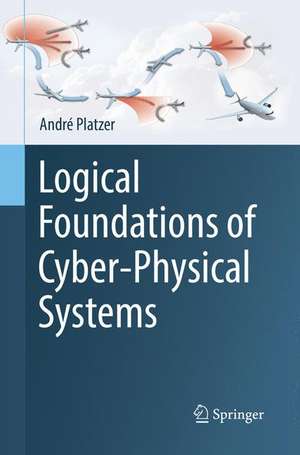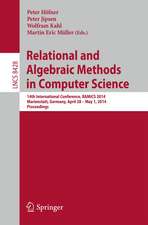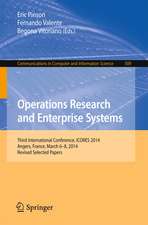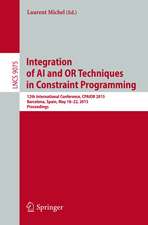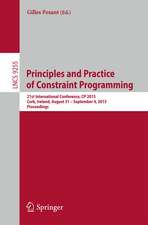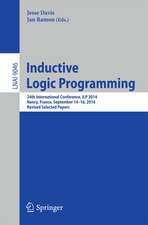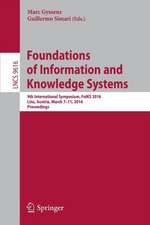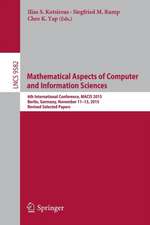Logical Foundations of Cyber-Physical Systems
Autor André Platzeren Limba Engleză Paperback – 8 feb 2019
This textbook teaches undergraduate students the core principles behind CPSs. It shows them how to develop models and controls; identify safety specifications and critical properties; reason rigorously about CPS models; leverage multi-dynamical systems compositionality to tame CPS complexity; identify required control constraints; verify CPS models of appropriate scale in logic; and develop an intuition for operational effects.
The book is supported with homework exercises, lecture videos, and slides.
| Toate formatele și edițiile | Preț | Express |
|---|---|---|
| Paperback (1) | 350.86 lei 43-57 zile | |
| Springer International Publishing – 8 feb 2019 | 350.86 lei 43-57 zile | |
| Hardback (1) | 357.63 lei 43-57 zile | |
| Springer International Publishing – 11 aug 2018 | 357.63 lei 43-57 zile |
Preț: 350.86 lei
Preț vechi: 438.57 lei
-20% Nou
Puncte Express: 526
Preț estimativ în valută:
67.16€ • 72.97$ • 56.45£
67.16€ • 72.97$ • 56.45£
Carte tipărită la comandă
Livrare economică 21 aprilie-05 mai
Preluare comenzi: 021 569.72.76
Specificații
ISBN-13: 9783030096977
ISBN-10: 3030096971
Pagini: 639
Ilustrații: XXXI, 639 p. 182 illus., 176 illus. in color.
Dimensiuni: 155 x 235 mm
Greutate: 0.93 kg
Ediția:Softcover reprint of the original 1st ed. 2018
Editura: Springer International Publishing
Colecția Springer
Locul publicării:Cham, Switzerland
ISBN-10: 3030096971
Pagini: 639
Ilustrații: XXXI, 639 p. 182 illus., 176 illus. in color.
Dimensiuni: 155 x 235 mm
Greutate: 0.93 kg
Ediția:Softcover reprint of the original 1st ed. 2018
Editura: Springer International Publishing
Colecția Springer
Locul publicării:Cham, Switzerland
Cuprins
Cyberphysical Systems: Introduction.- Differential Equations and Domains.- Choice and Control.- Safety and Contracts.- Dynamical Systems and Dynamic Axioms.- Truth and Proof.- Control Loops and Invariants.- Events and Responses.- Reactions and Delays.- Differential Equations and Differential Invariants.- Differential Equations and Proofs.- Ghosts and Differential Ghosts.- Logical Foundations and CPS.- Differential Invariants and Proof Theory.- Verified Models and Verified Runtime Validation.- Hybrid Systems and Games.- Winning Strategies and Regions.- Winning and Proving Hybrid Games.- Game Proofs and Separations.- Virtual Substitution and Real Equations.- Virtual Substitution and Real Arithmetic.- Axioms and Uniform Substitutions.- Differential Axioms and Uniform Substitutions.- Model Checking and Reachability Analysis.- Distributed Systems and Hybrid Systems.
Notă biografică
André Platzer is an Associate Professor in the Computer Science Department at Carnegie Mellon University. He develops the logical foundations of cyberphysical systems to characterize their fundamental principles and to determine how we can trust computers to control physical processes. He has a Ph.D. from the University of Oldenburg, Germany. He received an ACM Doctoral Dissertation Honorable Mention and NSF Career Award, and he was named one of the Brilliant 10 Young Scientists by the Popular Science magazine and one of AI's 10 to Watch by the IEEE Intelligent Systems Magazine.
Textul de pe ultima copertă
Cyber-physical systems (CPSs) combine cyber capabilities, such as computation or communication, with physical capabilities, such as motion or other physical processes. Cars, aircraft, and robots are prime examples, because they move physically in space in a way that is determined by discrete computerized control algorithms. Designing these algorithms is challenging due to their tight coupling with physical behavior, while it is vital that these algorithms be correct because we rely on them for safety-critical tasks.
This textbook teaches undergraduate students the core principles behind CPSs. It shows them how to develop models and controls; identify safety specifications and critical properties; reason rigorously about CPS models; leverage multi-dynamical systems compositionality to tame CPS complexity; identify required control constraints; verify CPS models of appropriate scale in logic; and develop an intuition for operational effects.
The book is supported with homework exercises, lecture videos, and slides.
This textbook teaches undergraduate students the core principles behind CPSs. It shows them how to develop models and controls; identify safety specifications and critical properties; reason rigorously about CPS models; leverage multi-dynamical systems compositionality to tame CPS complexity; identify required control constraints; verify CPS models of appropriate scale in logic; and develop an intuition for operational effects.
The book is supported with homework exercises, lecture videos, and slides.
Caracteristici
Supported with detailed lecture notes, lecture videos, homework assignments, and lab assignments Cornerstone of author's course is hybrid programs (HPs), capturing dynamical aspects of cyber-physical systems (CPSs) in a simple programming language Teaches skills required to formally analyze ubiquitous CPSs, such as power plants and pacemakers Author's website (http://lfcps.org/lfcps/) includes video tutorials, slides, tools and other supports Includes supplementary material: sn.pub/extras
